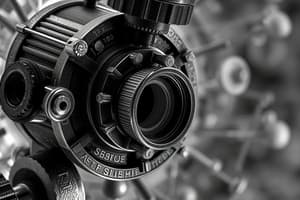Podcast
Questions and Answers
What is the primary function of a Scanning Electron Microscope (SEM)?
What is the primary function of a Scanning Electron Microscope (SEM)?
- To record information about the interaction between light and the sample to create a magnified image
- To use a fine beam of focused electrons to scan a sample's surface and create a magnified image (correct)
- To magnify an image up to 2 million times using a focused beam of light
- To analyze the chemical composition of a sample using X-rays
What kind of information can be revealed about the sample by the signals derived from electron-sample interactions in an SEM?
What kind of information can be revealed about the sample by the signals derived from electron-sample interactions in an SEM?
- Chemical composition and crystalline structure of materials making up the sample (correct)
- Only the external morphology (texture) of the sample
- Only the spatial variations in properties of the sample
- Only the crystal orientations of materials making up the sample
What is the SEM capable of analyzing in the selected point locations on the sample?
What is the SEM capable of analyzing in the selected point locations on the sample?
- Chemical compositions, crystalline structure, and crystal orientations (correct)
- Only the chemical compositions using X-rays
- Only the spatial variations in properties of the sample
- Only the external morphology (texture) of the sample
How does kinetic energy from accelerated electrons in an SEM get dissipated in a solid sample?
How does kinetic energy from accelerated electrons in an SEM get dissipated in a solid sample?
What does EDS stand for in relation to the capabilities of an SEM?
What does EDS stand for in relation to the capabilities of an SEM?
Which signal is most valuable for illustrating contrasts in composition in multiphase samples?
Which signal is most valuable for illustrating contrasts in composition in multiphase samples?
What is the essential component of all SEMs that includes the electron source and detectors for all signals of interest?
What is the essential component of all SEMs that includes the electron source and detectors for all signals of interest?
What is produced by inelastic collisions of the incident electrons with electrons in discrete orbitals (shells) of atoms in the sample?
What is produced by inelastic collisions of the incident electrons with electrons in discrete orbitals (shells) of atoms in the sample?
What does SEM analysis consider to be 'non-destructive'?
What does SEM analysis consider to be 'non-destructive'?
What can SEMs equipped with diffracted backscattered electron detectors (EBSD) be used to examine?
What can SEMs equipped with diffracted backscattered electron detectors (EBSD) be used to examine?
Flashcards
Function of SEM
Function of SEM
Uses focused electrons to scan surfaces and create magnified images.
Information revealed by SEM
Information revealed by SEM
Reveals chemical composition and crystalline structure of materials.
Point location analysis in SEM
Point location analysis in SEM
Analyzes chemical compositions, crystalline structures, and orientations.
Energy dissipation in SEM
Energy dissipation in SEM
Signup and view all the flashcards
EDS in SEM
EDS in SEM
Signup and view all the flashcards
Valuable signal for contrasts
Valuable signal for contrasts
Signup and view all the flashcards
Essential SEM component
Essential SEM component
Signup and view all the flashcards
Characteristic X-rays
Characteristic X-rays
Signup and view all the flashcards
Non-destructive SEM analysis
Non-destructive SEM analysis
Signup and view all the flashcards
EBSD in SEM
EBSD in SEM
Signup and view all the flashcards
Study Notes
Scanning Electron Microscope (SEM)
- The primary function of an SEM is to produce high-resolution images of the sample surface by scanning it with a focused beam of electrons.
Electron-Sample Interactions
- Signals derived from electron-sample interactions in an SEM can reveal information about the sample's topography, morphology, and composition.
- These interactions can produce a range of signals, including secondary electrons, backscattered electrons, and X-rays, which provide valuable information about the sample.
Point Analysis
- The SEM is capable of analyzing the composition of the sample at selected point locations, enabling the identification of elemental distributions and chemical compositions.
Energy Dissipation
- The kinetic energy from accelerated electrons in an SEM is dissipated in a solid sample through heat generation, causing the sample to warm up.
EDS
- EDS stands for Energy-Dispersive Spectroscopy, which is a capability of an SEM that enables the analysis of the elemental composition of a sample.
Contrast in Composition
- The X-ray signal is most valuable for illustrating contrasts in composition in multiphase samples, as it provides information about the elemental distribution.
Essential Component
- The essential component of all SEMs is the electron column, which includes the electron source and detectors for all signals of interest.
Inelastic Collisions
- Inelastic collisions of the incident electrons with electrons in discrete orbitals (shells) of atoms in the sample produce X-rays.
Non-Destructive Analysis
- SEM analysis is considered 'non-destructive' because the sample is not damaged or altered during the analysis process.
EBSD
- SEMs equipped with diffracted backscattered electron detectors (EBSD) can be used to examine the crystal structure and orientation of materials.
Studying That Suits You
Use AI to generate personalized quizzes and flashcards to suit your learning preferences.
Description
Learn about the basics of Scanning Electron Microscope (SEM), including its functionality and potential magnification. Understand how SEM uses electron beams to scan a sample's surface and record information about the interaction, creating a magnified image.



